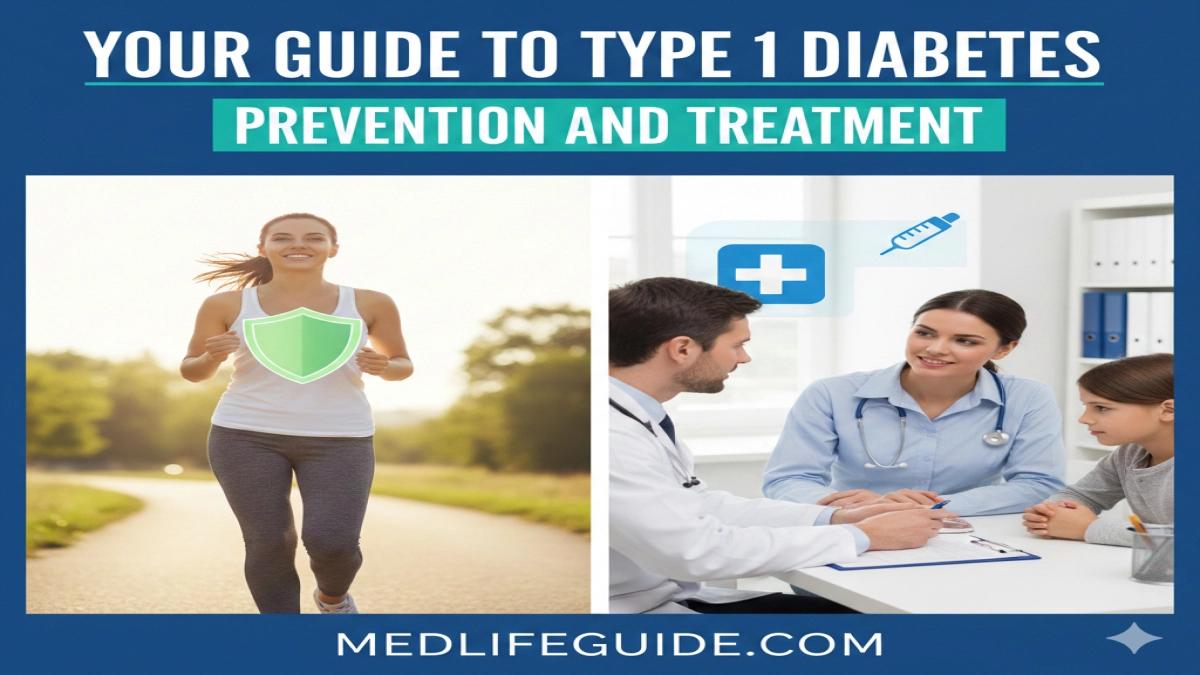Medically Reviewed and Compiled by Dr. Adam N. Khan, MD.
Here’s the short version. Type 1 diabetes happens when the immune system destroys insulin-making cells in the pancreas. There is no cure yet, but there are ways to slow early damage, lower risks, and manage blood sugar with better safety and control. The rest of this guide breaks down how prevention, early detection, and modern treatment work.
Understanding Type 1 Diabetes
Type 1 diabetes is an autoimmune condition. The immune system targets and destroys beta cells in the pancreas. Without insulin, blood sugar rises and the body cannot use glucose for energy.
People of any age can develop it, but it often starts in childhood, teens, or early adulthood.
Causes and Risk Factors
Genetic Risk
A person with a parent or sibling who has type 1 diabetes has a higher chance of developing it, but it is still not fully predictable.
Autoimmune Triggers
Certain viral infections can activate the immune system in a way that increases risk in genetically vulnerable people.
Environmental Factors
Possible contributors include early childhood immune responses, low vitamin D levels, or changes in the gut microbiome. Research is still ongoing.
Early Prevention and Risk Reduction
There is no guaranteed method to stop type 1 diabetes from developing, but certain steps reduce risk in high-risk individuals or slow autoimmune damage in the earliest stage.
Screening Programs
Children with a family history may benefit from:
- Autoantibody testing
- Glucose tolerance checks
- Regular A1C monitoring
Catching early immune activity can delay symptoms.
Immune Modulation Therapy
Newer therapies such as anti-CD3 treatment (for example, teplizumab) may delay the start of type 1 diabetes in high-risk teens and adults.
Vitamin D Adequacy
Some studies show that healthy vitamin D levels may support immune balance. Supplementing should be tested and guided by a clinician.
Infection Prevention
Good hygiene, vaccination, and avoiding exposure to viral infections may lower triggers linked to autoimmune reactions, especially in high-risk children.
Core Treatments for Type 1 Diabetes
Insulin Therapy
Most people rely on:
- Long-acting insulin
- Rapid-acting insulin for meals
- Smart pens or insulin pumps
Pumps paired with continuous glucose monitors can help create a steady pattern of control.
Blood Sugar Monitoring
CGMs (Continuous Glucose Monitors) provide real-time readings and alarms for low or high sugar levels.
Meal Planning
A steady eating pattern helps prevent spikes. Counting carbohydrates allows more accurate insulin dosing.
Exercise
Activity improves insulin sensitivity and may reduce long-term complications.
Emergency Awareness
Patients and families should know how to use glucagon for severe low blood sugar.
Unique Clinical Takeaways
Here is where things get more practical and more advanced. These points come from real patient patterns, research, and clinical decision-making.
1. Early Stage Autoimmunity Is a Hidden Window of Opportunity
Before symptoms appear, the immune system may already be attacking beta cells. This stage often lasts months or years.
The real benefit of early screening is not only prediction, but the chance to delay onset. Studies show that immune-modifying therapies can hold off symptoms long enough for kids to grow older and families to prepare for long-term care. This shifts the entire treatment journey.
2. Mental Fatigue and Burnout Are Strong Predictors of Poor Control
Many people believe high blood sugar comes only from poor food choices or bad insulin timing. What actually shows up in clinic visits is emotional stress, disrupted sleep, and burnout.
Teens and adults who feel overwhelmed often miss doses or ignore alarms. Addressing mental load early helps improve control more than adjusting insulin by a few units.
3. Differential Diagnosis Still Matters, Even in Children
Not every young patient with high blood sugar has type 1 diabetes.
Some cases turn out to be:
- Monogenic diabetes
- Type 2 diabetes
- Steroid-induced diabetes
These require very different plans. Genetic testing and C-peptide levels are more important today than they were ten years ago because treatment options are now broader.
4. Eating Patterns Influence Glucose More Than Food Type Alone
Two patients may eat the same meal and get different results. Why?
The timing of meals, how fast they eat, and the order in which they eat foods can change the glucose curve. Eating protein or vegetables before carbohydrates often softens blood sugar spikes in many patients.
5. Early Foot and Eye Checks Make Complications Less Likely
Damage does not happen overnight. Many problems start silently. When people get eye exams and nerve checks early, doctors catch tiny issues before they turn into real trouble. This simple step saves vision and mobility later.
Living With Type 1 Diabetes
Daily Routines That Help
- Regular meal timing
- Checking glucose before and after exercise
- Carrying snacks or glucose tablets
- Keeping insulin supplies in temperature-safe storage
When To Contact a Doctor
- Frequent lows
- Unusual high readings
- Ketones in urine
- Sudden weight changes
- Signs of depression or burnout
Family and School Support
Kids benefit when teachers, coaches, and caregivers understand signs of low blood sugar and how to respond quickly.
Long-Term Health Protection
Heart Health
People with type 1 diabetes have a higher risk of heart disease. Healthy eating, active living, and regular checkups help reduce this.
Kidney Health
Keeping A1C in range and maintaining normal blood pressure helps protect the kidneys.
Eye Protection
Yearly dilated eye exams catch early changes that can be treated before sight is affected.
References and Citations
(Internal linking format, as requested)
- American Diabetes Association – Standards of Care in Diabetes
- National Institute of Diabetes and Digestive and Kidney Diseases (NIDDK) – Type 1 Diabetes
- JDRF – Type 1 Diabetes Research and Prevention
- NEJM – Teplizumab Therapy in Relatives at Risk for Type 1 Diabetes
- Mayo Clinic – Type 1 Diabetes Overview and Care Guidelines
Medical Disclaimer
This article is for education only. It does not replace medical advice, diagnosis, or treatment. Always speak with a qualified healthcare professional about your personal health needs.

